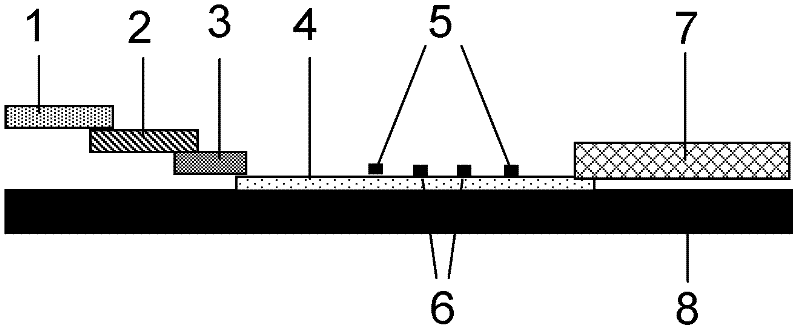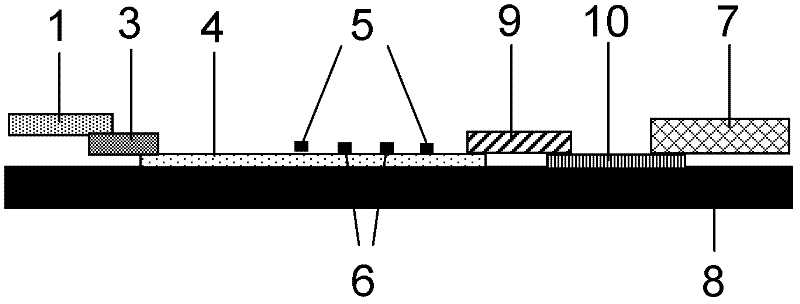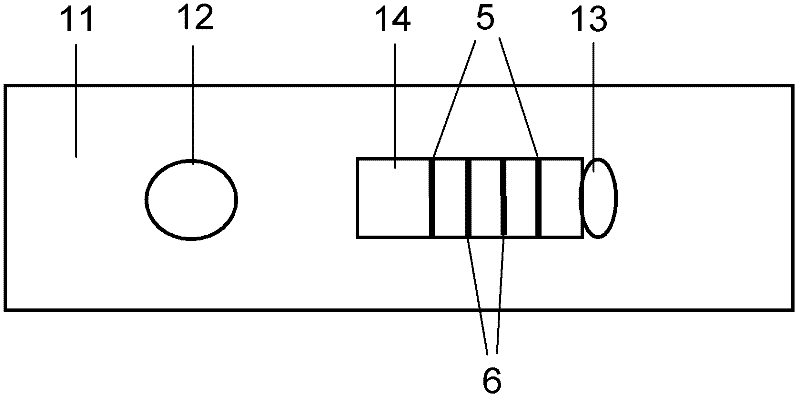Fluorescence immunochromatographic assay and kit for quantitatively detecting N-terminal pro brain natriuretic peptide
A fluorescence immunochromatography and quantitative detection technology, applied in the field of medical testing, can solve the problems of low sensitivity, expensive instruments, and inaccurate quantification, and achieve the effect of improving detection sensitivity and sensitivity.
- Summary
- Abstract
- Description
- Claims
- Application Information
AI Technical Summary
Problems solved by technology
Method used
Image
Examples
Embodiment 1
[0070] Example 1: Quantitative detection of NT-proBNP by modifying antibodies to quantum dots by chemical cross-linking and using direct pre-wetting immunochromatography
[0071] (1) Modification of quantum dots and antibodies
[0072] Add 60pmol quantum dots with an emission wavelength of 650nm, 10μg EDC, 15μg NHS solution and 10-30μg goat anti-human NT-proBNP monoclonal antibody solution to pH 7.4 phosphate buffer solution, mix well and react at room temperature for 4h, add 1mg glycine to block . Separating and purifying with a chromatographic column or a chromatographic column to obtain NT-proBNP antibody-modified quantum dots. Similarly, quantum dots modified with goat anti-rabbit antibody were obtained. The fluorescence emission wavelength of the quantum dot modified by the NT-proBNP antibody is 650nm, and the fluorescence emission wavelength of the quantum dot modified by the goat anti-rabbit antibody is 570nm.
[0073] (2) Construction of the kit
[0074] Mix the ab...
Embodiment 2
[0082] Example 2: Quantitative detection of NT-proBNP by modifying antibodies to quantum dots by biotin-avidin method and using indirect pre-wetting immunochromatography
[0083] (1) Synthesis and modification of quantum dots
[0084] According to the method of Example 1, streptavidin-modified quantum dots were prepared. Similarly, quantum dots modified with goat anti-rabbit antibody were obtained.
[0085] Dilute NT-proBNP monoclonal antibody to 1mg / ml with 0.1mol / L sodium bicarbonate buffer (pH 8.0), dissolve 1mg N-hydroxysuccinimide biotin (NHSB) with 1ml dimethyl sulfoxide (DMSO), Take 1ml monoclonal antibody solution and add 20-120μl NHSB solution, and react at room temperature for 4 hours. Add 1mol / L NH 4 Cl, stirred at room temperature for 10 min. Purify by ultrafiltration centrifugation to remove free biotin to obtain biotinylated mAb.
[0086] Streptavidin-modified quantum dots and biotinylated monoclonal antibodies are mixed at a ratio of 1:3 to 1:12 to obtain N...
PUM
| Property | Measurement | Unit |
|---|---|---|
| Emission wavelength | aaaaa | aaaaa |
| Emission wavelength | aaaaa | aaaaa |
| Emission wavelength | aaaaa | aaaaa |
Abstract
Description
Claims
Application Information
 Login to View More
Login to View More - R&D
- Intellectual Property
- Life Sciences
- Materials
- Tech Scout
- Unparalleled Data Quality
- Higher Quality Content
- 60% Fewer Hallucinations
Browse by: Latest US Patents, China's latest patents, Technical Efficacy Thesaurus, Application Domain, Technology Topic, Popular Technical Reports.
© 2025 PatSnap. All rights reserved.Legal|Privacy policy|Modern Slavery Act Transparency Statement|Sitemap|About US| Contact US: help@patsnap.com



